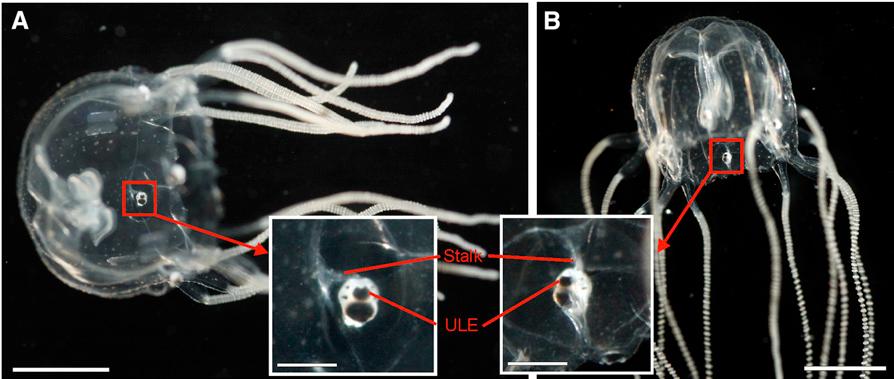At just one centimetre across, the box jellyfish - Tripedalia cystophora for lovers of Latin - makes a poor contender for being a paragon of intellect. But now  new research has show that these tiny creatures can actually navigate by following the outlines of objects in the sky above them.
new research has show that these tiny creatures can actually navigate by following the outlines of objects in the sky above them.
The jellyfish live in-shore among the roots of mangrove trees where they prey upon tiny light-loving plankton species that gather in sunny spots along the margins of the swampy surroundings. But if they wander too far from the shoreline and away from their food source, the jellyfish risk starvation; consequently they are rarely found out in open water.
So how do they avoid being swept away?
University of Copenhagen scientist Anders Garm and his colleagues suspected that the jellyfish might be making use of the 24 "eyes" that adorn structures called rhopalia on each of the four sides of the animal's box-shaped body. Surprisingly, two of the eyes in each rhopalium, one looking up and one looking down, actually use a lens system similar to our own to focus light.
To find out what this upward-gazing eye might be capable of seeing, the researchers used a wide-angle lens to take photographs from just below the water surface. The pictures reveal that, owing to the way that water causes light to bend or refract, each eye would be capable of surveying a 180 degree field of view. And from distances of up to 8 metres away, the outline of the mangrove canopy against the sky would be clearly visible to the jellyfish, providing them with fixed reference point to keep them close to home.
Working in a mangrove swamp in Puerto Rico, the researchers then tested the theory by placing locally-caught box jellyfish into a floating, circular open-toppped tank that was partially submerged in the seawater. This meant that the animals could see the sky, and the overlying trees, but were isolated from any water-borne chemical cues that might provide navigational aids.
The researchers then slowly moved the tank different distances away from the shore and watched the movements of the jellyfish. Incredibly, at distances up to 8 metres, they all swam towards the shore-facing side of the tank. At distances greater than 8 metres, the animals moved randomly again, consistent with having lost the visual reference of the treeline, just as the underwater photographs had predicted.
The team don't know exactly how this intelligent photaxic behaviour is achieved but they speculate that it could be a neurological adaptation of a solar compass. The animals actually lack brains, although each rhopalium carries an associated nerve ganglion equipped with 1000 neurones, and a "ring nerve" links the four ganglia, presumably helping to coordinate the animal's response to what its eyes are seeing.
But regardless of how it works, as the team point out, their observations "defeat the idea that a central brain is a prerequisite for advanced behaviour."









Comments
Add a comment